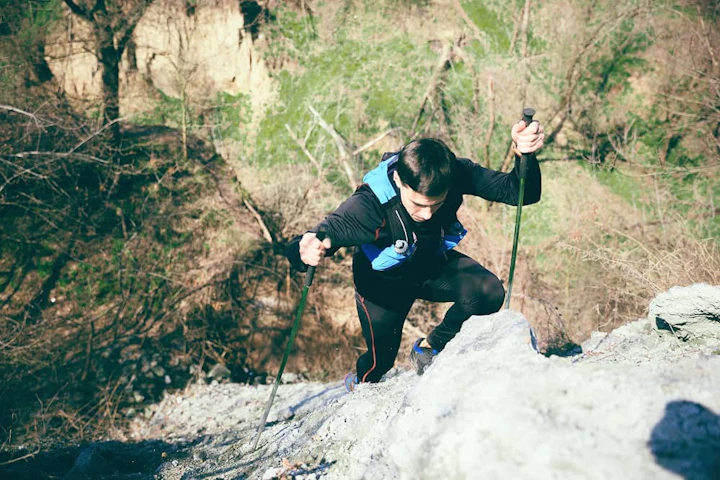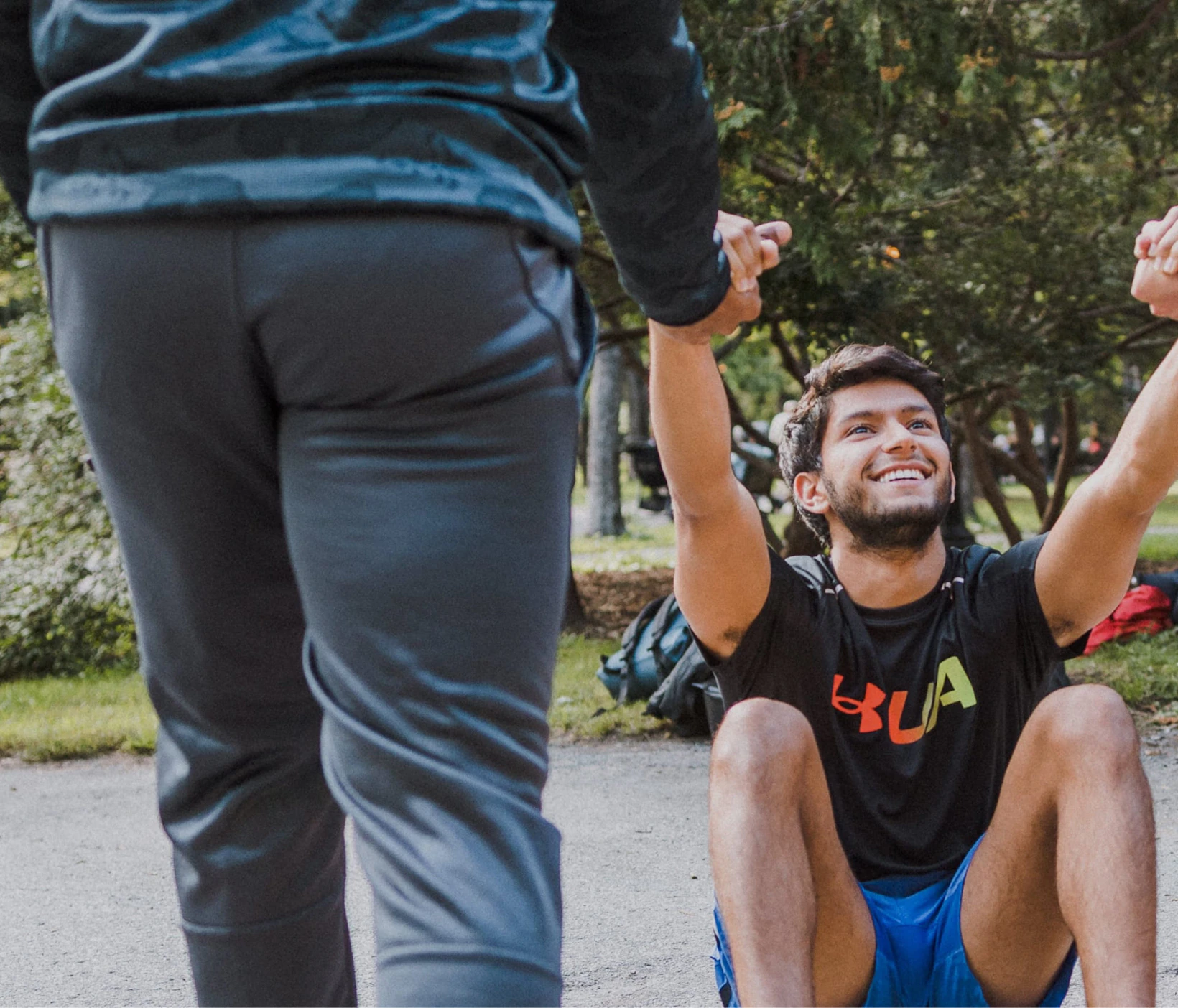
9 mins of reading
Summary
Trail running training plan: the specificities of the discipline
🏔️ Trail running, mountain trail… an incomparable variability of terrains
📈 Elevation: the primary feature of trail running
🚀 20 km, 40 km, 100 km, ultra trail… XXL distances that require a personalized trail running plan
The basics of a personalized training plan for trail preparation: our tips
🔥 The importance of hill and interval workouts
🏋️♂️ Strength & Conditioning: an option that is not optional
🏃♀️ Beginner, advanced level: never skip the long run!
💥 The essential shock weekend to prepare for a short or long trail

Receive advice from our passionate coaches!
If Campus offers a trail running training plan, there is a reason. This discipline, a full part of the running world, has specific features that deserve dedicated preparation.
Whether you are a beginner trail runner or more experienced one, we strongly advise you to follow a plan designed for trail running, where you will find workouts adapted to your goal. For what reasons? We explain.
Trail running training plan: the specificities of the discipline
Trail running is an integral part of the running world. But just as you don't prepare for a 200-meter race like you prepare for a marathon, you don't prepare for a trail running race like you do for a road race. Focus on the specificities of this discipline!
🏔️ Trail running, mountain trail… an incomparable variability of terrains
The primary characteristic of trail running is the variability of its terrain. While road running becomes nature running when it includes trail segments, trail running is called so regardless of the environment. The main criterion is to progress outside the road.
Traditionally, trail running races are found in mountainous regions. But with the rise of the discipline, you can find them absolutely everywhere. From the Ultra Marin in the Gulf of Morbihan to the Ultra-trail du Mont-Blanc in the heart of the Chamonix valley, there's something for every taste! That's what makes the discipline so diverse.

📈 Elevation: the primary feature of trail running
Another key point that distinguishes trail running from road running: elevation. Whether positive (uphill) or negative (downhill), elevation is central in trail running. This additional data significantly changes preparation.
The running mechanics differ depending on whether you run uphill, on flat, or downhill. Muscle demands are not the same. You cannot approach trail running as you would do it for road running at the risk of underperforming or, worse, injuring yourself.
But don't panic! Elevation can be trained. By following an adapted trail running training plan, you will develop specific qualities suited to your future goal. Conversely, if you follow a plan aimed at road running, you might face some surprises on race day…
🚀 20 km, 40 km, 100 km, ultra trail… XXL distances that require a personalized trail running plan
In road running, the marathon and its 42.195 kilometers/26,22 miles represent a mythical distance. It is even nicknamed the “queen distance”. A handful of exceptional athletes tackle 100 kilometers or 24-hour events, but this remains exceptional.
In trail, the numbers explode and long distances are numerous! From a few kilometers, you can go up to several hundred. Remember our coach Mathieu Blanchard on the Yukon Arctic Ultra with its 625 kilometers/388,4 miles.
Obviously, the two disciplines are tackled differently. For example, we could cite the relationship to walking. Essential in trail running, it is synonymous with failure for many road runners (sometimes wrongly!). But the most important distinction remains the relationship to effort.
Indeed, the Mont-Blanc Marathon and its 2540 meters of positive elevation are not approached the same way as the Paris Marathon. Moreover, if you ask participants, you will quickly see that road runners' timing goals are much more precise than those of trail runners.
Thus, speed in trail takes a back seat to the perception of effort (RPE). That’s why at Campus, our trail running training plans set no pace goals. We only talk in RPE. It's the safest way to adapt to distances and elevations during training and competitions.
Effort zone table to determine your RPE 🔥
| Pace | Associated Perceived Effort Rating | Perceived Effort | % of Max HR |
|---|---|---|---|
Easy Endurance | 1-2 | Very easy (very slow pace / leisurely) | <70 % |
Fundamental endurance (FE) | 2-3 | Easy (slow and comfortable pace) | 70-77 % |
Active Endurance (AE) | 4-5 | Moderate (moderate pace / active / mild engagement) | 77-85 % |
60' Threshold / Sweet spot | 6-7 | Comfortably difficult (steady pace) | 85-92 % |
30' Threshold | 8 | Hard (high intensity) | 90-95 % |
V02 Max | 9 | Very hard (very high intensity) | 90-100 % |
Sprint | 10 | Maximum speed (maximum intensity) | / |
The basics of a personalized training plan for trail preparation: our tips
You now well understand why the specificities of the trail running require following a plan dedicated to this discipline. But what should a trail running training plan include to be relevant?
🔥 The importance of hill and interval workouts
In the context of trail running preparation, you won't escape the famous interval workouts. Because yes, they are valuable no matter the type of race and the goal targeted.
Of course, the content might differ from that found in road running programs. For example, you’ll find many hill training workouts, essential in this discipline. Uphill, they will help you adapt your stride to the slope’s inclination and do specific muscle work, especially on the posterior chain and ankles.
But when you go uphill, you must also go downhill (you learn things with Campus!). However, downhills can cause significant muscle damage often underestimated. They demand significant effort from the quadriceps.
The latter will have to absorb shocks during an eccentric effort to which the body is less accustomed. Tendons and joints will also bear the brunt. Thus, the so-called “hill training” is actually a misnomer! It concerns both the uphills and the downhills.
Finally, contrary to popular belief, MAS, 30' Threshold and 60' Threshold will also be present! It’s not about totally forgetting speed qualities.
It was long considered that if road running was the hare, trail running was the tortoise. That is false. A trail running includes rolling sections where you have to pick up speed again. It also includes downhills where you might be in over-speed, a pace you should train!
🏋️♂️ Strength & Conditioning: an option that is not optional
Did you think burning your legs on hills would exempt you from Strength & Conditioning? Wrong! For trail running as for road running, it is mandatory.
A recent Finnish study published in the British Journal of Sport Medicine investigated the impact of Strength & Conditioning on the injury risk among recreational runners. It shows that the occurrence of overuse injuries was 39% lower for runners who did hip and core strength workouts.
What can you take away from it? Simply that you should not limit your Strength & Conditioning to the muscles most used in running! Core exercises, lunges, Bulgarian squats… all these exercises allow you to work most muscle groups or almost all. Thus, you improve your performance while significantly reducing the risk of injury.
Need help to set up an effective Strength & Conditioning session? Campus includes them directly in its training plans!
🏃♀️ Beginner, advanced level: never skip the long run!
High-intensity work and Strength & Conditioning are great. But don't forget that trail running is a sport that requires long efforts. Here we exclude trail running races of a few kilometers and Vertical Kilometers (KVs), specific formats that are a bit exempt from this rule.
For the rest, you'll need to comply with the famous long run. Essential for developing your endurance capacity, it is done at a comfortable pace that allows you to enjoy the scenery. Because yes, this run should preferably be done off-road, on hilly terrains with uneven grounds. You should put yourself in nearly the same setup as race day to properly prepare for your goal!
Moreover, you’ll quickly notice the duration of long runs is particularly important. If you are from the road, this might unsettle you. Don't panic; it's normal! Trail running efforts are managed differently, as explained above.
Fatigue is not the same. Thus, effort times can significantly extend without fatigue correlating with what you would feel on the road. Indeed, you'll quickly realize that the mileage for the same running time will be entirely different.
💡 Our tips? Stay in a comfort zone with base endurance, even uphill. Adapt your paces to the terrain and don’t hesitate to walk, much if necessary. Finally, work on your fueling and hydration strategy.
This way, you maximize your chances to optimize your progress over the kilometers.

💥 The essential shock weekend to prepare for a short or long trail
Here we touch on a true specificity of a trail running training plan, both famous and feared. The shock weekend. As its name implies, it will contain a significant training volume, spread over two days, or more.
Specifically, you’ll sequence two long runs in two days. On paper, it’s that simple. At Campus, the shock weekends are scheduled relatively close to the goal. They help improve race management, particularly fatigue management.
You’ll quickly find your legs feel heavy on the second day. You'll have to deal with this sensation. This will help you on race day, physically and in terms of your mental strength preparation.
⚠️ But be careful! A shock weekend can only be effective if it is accompanied by a period of good recovery. Rest is indeed essential to assimilate such stress for your body. If you don't take recovery time, what should be an asset becomes counterproductive.
In conclusion, crafting the ideal trail running training plan is paramount for success in any trail race, from shorter distances to a daunting 100 mile challenge. Your training schedule should always begin with a realistic starting point, gradually building your aerobic endurance through consistent long runs and well-placed easy runs on your easy days. Remember the critical role of rest days and incorporating cross training and strength training to prevent sore muscles and minimize overuse injuries. While it's tempting to always push a fast pace, varying your running pace and monitoring your heart rate ensures effective adaptation. Ultimately, the best training programs are those that are specific to your trail race goal, allowing you to arrive at the start line strong, healthy, and ready to conquer the trails.
If you've made it this far, you can no longer ignore the importance of following a training plan designed for trail running when preparing for such a goal. At first glance, the content of a trail running training plan is not radically different from the one of a road race. But the devil is in the details.
Uphills, downhills, XXL long runs, shock weekends… all these specificities make trail preparation unique. So don't hesitate and turn to a plan designed for this discipline!

Nolwenn
Published on , updated on
share

Receive advice from our passionate coaches!
In the same category
Share this post



